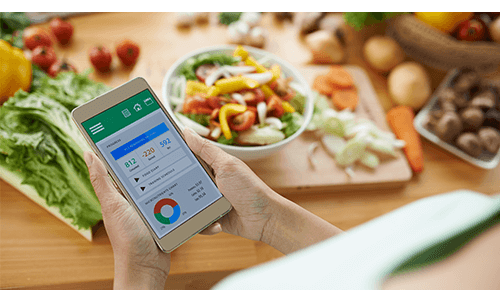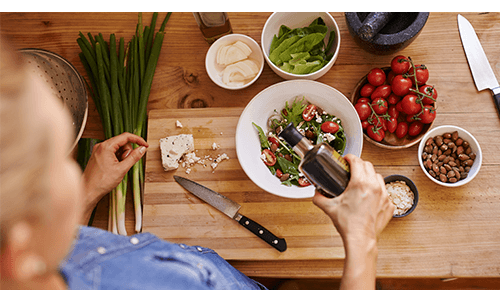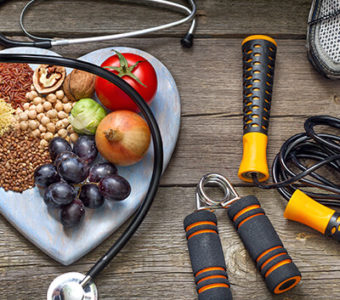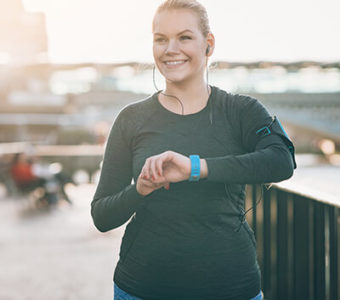Weight loss is all about calories — how many you consume and how many you burn off.
A lot of people think calories represent how fattening food is, but calories are just a measure of the energy food provides. We start to gain weight when we take in more energy than we expend through activity, regardless of whether those calories come from fat, sugars or protein.
So, how do you make sure your mix of eating right and exercise is optimal for your weight loss goal? Try these tips.

Track calories
Mobile apps like MyFitnessPal and WeightWatchers, and fitness devices like a Fitbit or an Apple Watch can help you track the calories you’re eating and the calories you’re burning through activity.
“I equate MyFitnessPal to a bank account,” says Stephanie, a Diabetes Prevention Program participant. “When I use cash, I end up not knowing how I’ve spent it, similar to when I eat food that I don’t track. But tracking my food is like using a debit card, where I can check my transactions online every day and see what my remaining balance is.”
Some of these tools also help you determine what your recommended daily calorie intake should be for you to reach your weight-loss goal, based on your age, sex, weight and height. For a healthy weight loss goal of 1 to 2 pounds each week, most people need to reduce calorie intake by at least 500 calories per day.
“You can reach your goals by eating less or increasing your activity level, but doing both makes it easier,” says Danielle Repko, an American Council on Exercise-certified health coach at OhioHealth Group. “For example, burning 3,500 calories a week to lose 1 pound might seem daunting at first, but if you break it up, you only have to eat 250 fewer calories, and burn 250 calories through exercise each day.”
Once you start to track your calories, you’ll also start to realize how much work it takes to burn off the calories you consume, making you think twice about the foods you choose to eat.

Make healthy swaps
Repko says you can reduce calorie intake by making small changes that add up. Try these substitution ideas to make your meals low-calorie:
- Use olive oil or margarine instead of butter
- Fill your plate with more vegetables instead of meats or grains
- Use vinaigrette instead of creamy dressings
- Choose a side salad or fruit instead of chips or fries
- Pick soup made with broth instead of a cream-base
- Eat cereal with fat-free milk instead of whole milk
- Use seasonings instead of salt

Rethink your drinks
Another way to cut calories is to change what you drink. By choosing to drink water or sparkling water instead of soda, you can save yourself more than 200 calories a day!
“Most people forget about drinks,” says Repko. “Just because you’re drinking them and not eating them, doesn’t mean they don’t have calories.” And don’t forget about serving sizes — read the nutrition label. Often, a full bottle is more than one serving, and many more calories than you think.
Here are some ideas to help you make better drink choices:
- Carry a water bottle with you and keep it filled so you’re not tempted to buy other drinks
- Flavor your water with zero-calorie drink mixers, or infuse it with fruits or cucumbers
- Skip the whipped cream or flavor pumps in your coffee
- Order a child’s size drink or the smallest size available

Increase your activity
Exercise is obviously an effective method of burning calories. But, if the goal of 150 minutes of exercise each week seems intimidating, start by making a plan to incrementally increase your activity. For example, in week one, you might only walk for 10 minutes, three days a week. By week three, though, you might be up to 20 minutes at a time, seven days a week.
Building muscle through strength exercises is also an effective way to burn more calories. Maybe try carrying dumbbells while walking or add ankle weights. Find whatever works for you. We’ve listed some ideas to get you started, and if you want more ideas, check out the OhioHealth blog.
- Resistance band bicep curls
- Three ways to do a push-up
- Playground workouts (Download a PDF of all three exercises here)

Update your Action Plan
Get creative and brainstorm ways you can make healthy food and drink choices to consume fewer calories, and ways you can up the ante on your workout routine. Record your ideas in your action plan.
And remember why you’re doing this: to prevent Type 2 diabetes. Celebrate your progress along the way, even if it takes you time to reach your goals.
“I used to put on 6 to 10 pounds a year,” says one Diabetes Prevention Program participant. “Over this past year, I’ve lost 4 pounds. I haven’t reached my goal weight, but I haven’t gained more. I think that’s great.”
If you need extra help, join an official Diabetes Prevention Program! Check with your employer (OhioHealth offers a program for associates), your local YMCA or the Centers for Disease Control and Prevention’s list of recognized locations to find a program near you.
Categories: Diabetes, Eating Well
Series: Reshaping Your Health





